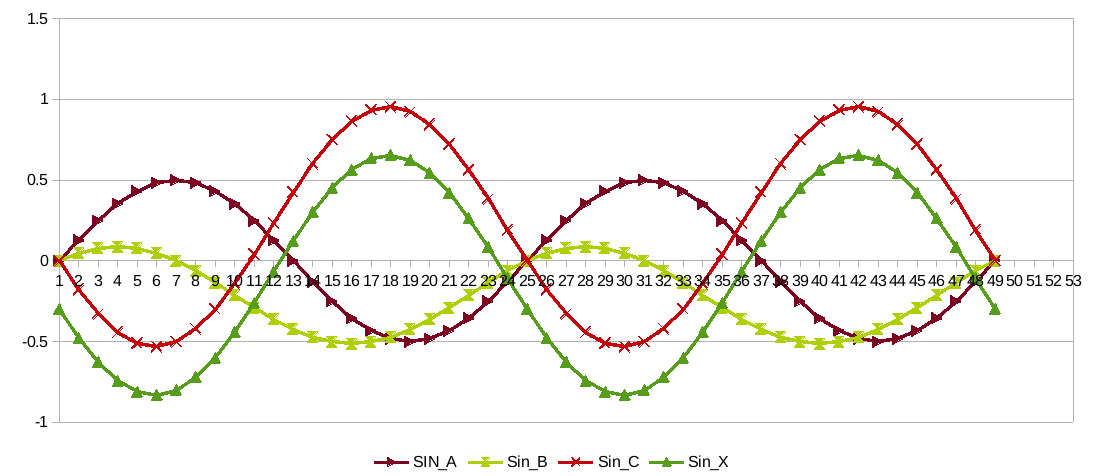CERN Faster Than Light Neutrino Experiment
There is one more question about the Aurora Effect. According to the explanation given above (see ref. # 2), that experiment has to show the Aurora Effect. That is correct for undisturbed clocks. But both clocks experienced artificial changes in their indications according to human “comprehension” of their “right indications.” It is time to come back to the following figure of the Aurora Effect.

The general way of CERN Experimet
In the experiment, the staff takes distance C2-B as the constant distance that the neutrino beam covers in each measurement. However, the physical distance covered by the neutrino beam appears as a variable distance from E1-B (the greatest distance) to D1-B (the smallest distance).
At the same time, the satellite signal had a similar deviation in covered distances regarding each point of measurement (CERN and OPERA). As soon as they use the moment of signal detection as a moment that shows them a calculated distance covered by the signal, they set clocks to an exact indication regardless of the physical distance covered by the satellite signal in one-way propagation. The following figure shows that case.

Two ways Aurora sinusoidal deviation
Suppose the satellite signal covers some distance and meets the detecting device located at the point of measurement. According to the description given above, the signal has some deviation at every measurement.
Suppose now that a GPS satellite is located in space and sends a signal toward the Earth. The signal has zero duration at the initial point D0 at the moment of emission.
The signal travels some distance in the medium to reach the detecting device located at the point of OPERA location, which is equal to P10-P21. At that very moment, the satellite clock shows an indication of D2.
The observer located at the OPERA point of measurement uses his imagination about signal propagation, as explained above. He thinks that the signal covers a distance equal to P1-P41 = P2-P42 = P3-P43, etc., or a constant distance.
He also thinks the signal keeps a constant propagation speed in the observer-bound reference frame. According to his calculations, the duration of signal propagation should be equal to D4 (D4 minus D0 = 0 equals D4). He sets the indication of D4 when it should be set to D2. As a result, an atomic clock at the OPERA point of measurement deviates from its correct indication for the value D4-D2.
Moreover, the observer makes “synchronization” of a clock by the satellite signal each time before the measurement of neutrino beam propagation. As a result, the observer meets a huge synchronization problem because any “correction” given to the clock at the previous “synchronization” becomes wrong at the next one because of the Aurora Effect. OPERA staff had no idea about that effect and made “synchronization” repeatedly before each measurement.
According to the figure, the Aurora Effect (red curved line) reaches its maximal value at point P31, which coincides with orientation P1 of the measuring instrument (satellite to OPERA point of measurement)—in other words, changing the orientation of the measuring instrument from P0 to P1 results in changing the duration of signal propagation from D2 to D3. At the same time, that change shifts clock indication artificial error from (D5-D2) to (D5-D3). In other words,
Clock artificial error made by “synchronization” with satellite clock and assumption about a constant speed of the signal in the observer-bound reference frame leads to deviation of clock indication equal in magnitude but opposite in sign regarding the moment of physical arrival of the measuring signal.
- Allan Zade
That error has a constant value or mean value (D5-D2) and maximal deviation on both sides (D5-D3) and (D5-D1). It has the opposite phase regarding the Aurora Effect because the clock has the maximal value of error (D5-D1) when the Aurora Effect shows its minimal value (D1-D0). That happens at orientation P3.
A similar way of action appears at another arm of measurement between the satellite and CERN. The figure shows that case in a blue curved line. In that case, the mean duration of the Aurora Effect becomes greater than expected (D7-D4). Apparently, the magnitude and phase of the Aurora Effect become different that way, as explained above.
Therefore, the deviation of the clock indication follows the Aurora Effect at both points of measurement, including some constant deviation that appears due to Earth-to-medium relative motion. The following figure shows the result in the case of a long experiment.

Four sinus Aurora Effect figure
That figure shows the deviation of clock indication at point A as SINA, the deviation of clock indication at point B as SINB, and the deviation of the duration of the neutrino beam propagation as SIN_C. As you can see, the deviation of both clocks taken with the opposite sign coincides with the deviation of the neutrino beam. Theoretically, it should give a correct result of the experiment.
However, the experiment had one more artificial value that appeared as some constant showing Earth-to-medium relative motion. As a result, the duration of neutrino beam propagation became less than its expected duration. That value "shifts" the calculated value of neutrino beam propagation in the Earth's crust for some constant detected during the experiment.
The figure shows that value as SINX. As you can see now, the difference between the supposed value of SINC and the detected value of SINX always keeps some constant value of (SINC—SIN_X) that was detected during all measurements as a constant superliminal speed of the neutrino beam.
CERN faster than light neutrino experiment was a really “twisted one” that can be understood entirely only after the destruction of some “fundamental” categories in your mind, including the category of so-called “physical time.”
- Allan Zade

